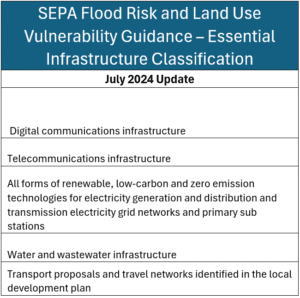Scotland Flood Risk and Essential Infrastructure
On the 18th July 2024, SEPA released updated guidance and criteria with regards to the Land Use Vulnerability for both existing and proposed developments, with respect to Flood Risk.
SEPA's Land Use Vulnerability Guidance - Essential Infrastructure Updates
On the 18th July, SEPA released updated guidance and criteria with regards to the Land Use Vulnerability for both existing and proposed developments, with respect to Flood Risk.
This comes after the publication of NPF4 in February 2023 which included significant changes to Flood Risk Assessments in comparison to the previous SPP.
Specifically, the guidance aims to add clarity to the first 3 exceptions when developments can be supported within a Flood Risk Area, which are as follows:
- Essential infrastructure where the location is required for operational reasons.
- Water compatible uses; and
- Redevelopment of an existing building or site for an equal or less vulnerable use
Essential Infrastructure
The definition of Essential Infrastructure in Scotland has been amended from the previous classification table (Version 4 , July 2018), which clarifies that this includes all forms of renewable, low carbon and zero emission technologies identified in NPF4 Policy 11 (wind farms, grid transmission and distribution infrastructure, as battery storage, pumped storage hydro etc) are permissible to be situated in Flood Risk Areas.
Although the first principal of Policy 22 is avoiding development in areas at flood risk, specific wording such as “has to be located in a flood risk area for operational reasons” which were present in the July 2018 classification table have been removed from the criteria. This wording change could potentially unlock flood risk for Essential Infrastructure development.
Another key alteration is that “Installations requiring hazardous substance consent” has been reallocated as a “Most Vulnerable” Land use, unless there is demonstrable need to locate such installations for bulk storage of materials with port or other similar facilities, or with energy infrastructure, that require a coastal or water side location, or other high flood risk areas, then the facilities should be classified as Essential Infrastructure).
2018 vs 2024 - What's the difference?
Comparisons between both the July 2018 and 2024 Essential Infrastructure Land Use Vulnerability definitions are presented here:


What this means for your development
This update from SEPA potentially unlocks the Flood Risk Area (i.e the 1 in 200 year plus climate change extent) for development that may not have been previously permitted under the Essential Infrastructure definition, including BESS, wind, solar and other zero-emission technologies.
However, the developer will however still need to demonstrate that:
- all risks of flooding are understood and addressed;
- there is no reduction in floodplain capacity, increased risk for others, or a need for future flood protection schemes;
- the development remains safe and operational during floods;
- flood resistant and resilient materials and construction methods are used; and
- future adaptations can be made to accommodate the effects of climate change
And that’s where we come in! At Aegaea we have supported many Essential Infrastructure development sites across Scotland and navigating the recent NPF4 criteria. This includes assisting with the layout of the site and reallocating development spaces in line with these new classifications. It will remain critical that the 5 points outlined above are considered early in the development process and our team of consultants, analysts and modellers are ready to assist you going forward
Drop us a line anytime to discuss your Essential Infrastructure project!
About the Author
Request your free, expert quote now
Aegaea work alongside home owners, private developers, planning consultants, architects, local authorities, international development agencies and contractors. Aegaea know exactly how to help you.